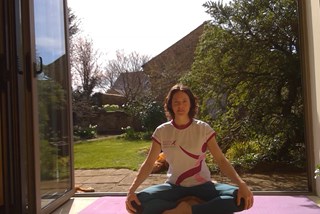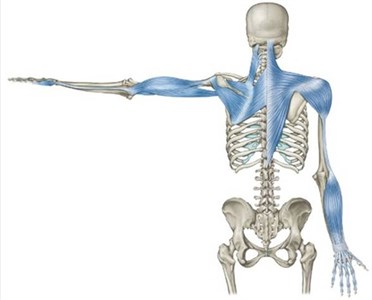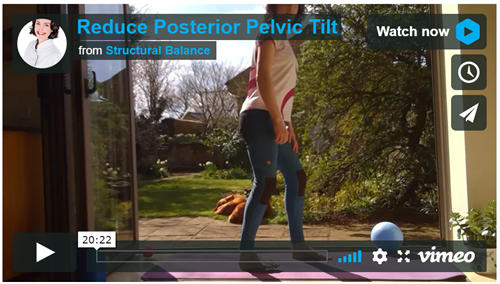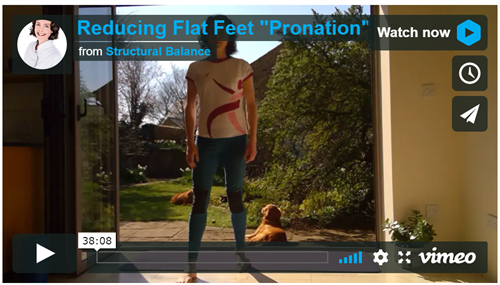
These videos are designed to help my clients who are going through sessions with me. They are designed to help change specific patterns or areas of the body that may be causing postural aches and pains. At the point of doing these videos you will have already had a consultation with me and we have discussed which may be the most helpful to you.
If you are visiting this site for the first time I suggest you get in touch with me to discuss what you are struggling with and we book an initial consultation which is free. This can be done in person or by video call.
If you have accessed these videos having not had a consultation, please ensure you understand your structure before doing any exercises as you may put yourself at risk. Often what we feel as pain, isn't the area causing the problem.
Unlimited access to these videos costs just £20 per year. By subscribing and paying only £20 you can access all videos I produce and watch them at your leisure.
Introduction
This is a 20 minute meditation I use to help maintain my balance. It's particuarly useful at the moment with COVID-19. The meditation takes you through tools to help ground and center yourself. You will learn how to cleanse your aura (your energy field) and improve the energy within your chakras. It finishes by helping you set up a protection barrier to protect your energetic self from any negative energy or stress that may affect you.
Understanding the Anatomy Trains Myofascial Lines
This is a basic introduction to the Anatomy Trains Myofascial Lines (AT). The AT lines are a model developed by Tom Myers, the creator of Anatomy Trains Structural Integration (ATSI) whom I trained with. Understanding these lines helps you to see and feel your structure.
- Superficial Front Line
- Superficial Back Line
- Lateral Line
- Deep Front Line
- Spiral Line
- Functional Line
You will begin to learn the basics of why you are finding your posture challenging and what you can do to help correct it.
In ATSI we work to balance your structure from feet to head. Without balanced foundations of support from the feet and legs, your pelvis and upper body will always compensate and be working harder than it should to keep you upright.
When you come for a free consultation with me, we will look at your structure together and understand why you are facing your current postural challenge or discomfort. Once understood we can work together through a series of sessions with me and some of homework to bring you back in balance and ease "making posture and movement easier".
The pelvis is key to the comfort, balance and movement of our body. It is the main focus of my work in your Structural Integration Sessions with me. The reason being if your pelvis is not balanced it affects your whole structure.
This video gives you a basic understanding of the different patterns your pelvis can be in and how they affect your whole body. These include:
- Anterior Pelvic Tilt
- Anterior Shift of Pelvis
- Posterior Tilt of Pelvis
- Horizontal Tilt of Pelvis
Please click here to read my latest newsletter inclusion of this video.
Reduce Anterior Pelvic Tilt
Here I will take you through creating lift in the Superficial Front and Deep Front Lines below the pelvis with the aim of reducing an anterior pelvic tilt.

Anterior pelvic tilts commonly create an excess lordosis of the lumbar spine and a posterior tilt of the ribcage. In this posture discomfort is often felt in the lower back, neck and shoulders. If left for a long time it can unfortunately compromise our spinal health and people may develop pathology in S1-L5 & L5-L4 and C7-C6 which are the areas under most strain.
Looking at the picture here, you can see the posterior tilt of the ribcage creates excess strain on the neck as the shoulders roll forward and the neck comes into an anterior tilt also.
I see many people trying to correct this by pulling their shoulders back which increases the posterior tilt of the ribcage creating more strain on the lower back and tension in the tops of the shoulders. To correct this pattern lift has to come from below the pelvis first.
It was my intention here to create a video that protects the areas that may be vulnerable in this postural pattern. It has no exercises above the pelvis because depending on the severity of the anterior pelvis tilt, working above the pelvis to create length isn't safe or useful at this stage.
Once the pelvis becomes closer to neutral we can begin to balance the upper body.
Reduce Posterior Pelvic Tilt
Here we look at reducing a Posterior Tilt of the pelvis by releasing the Superficial Back Line below the pelvis. This postural pattern is very common at the moment combined with an anterior shift of the pelvis. I am unsure why it has become "the most common pattern" I see in 2020. My guess is I observe people in this posture on their mobile devices and the over years, awareness of reducing an anterior pelvis tilt has grown. Now I see an over correction, a tucking under of the bottom that in many cases it's too much.
When in a posterior tilt of the pelvis our lumbar spine becomes very flat and people lack the ability to bend forward to pick things up off the floor. Absorbing forces from the ground up becomes jarring to the spine and sitting upright can become difficult. People in this posture find slouching on a chair with their bottom tucked under the most comfortable way to be. This brings compensation to the upper body and head and neck as the neck falls into an anterior tilt.
The soft tissue involved in holding the pelvis in a posterior tilt runs from underneath the base of the feet up to the lower glute complex. This video goes through a sequence to create length and movement in:
- Plantar Fascia of the feet
- Calves, Soleus and Tibialis Posterior
- Hamstrings
- Posterior adductors
- Lower glute complex
It creates more support for the lower back offering relief and improved hip mobility. It brings the ribcage back into balance above the pelvis easing the strain on the shoulders and neck.
Reducing Flat Feet and Pronation
In a "normal" foot, the mobility and balance of feet is controlled by the soft tissue structure. It acts as a pulley system and often "flat over pronated feet" only require some balance of these tissues to regain normal balance.
This video goes through a sequence to help the involved soft tissues firstly move and secondly act in balance to support the feet. The key to reducing a flat foot is Fibula and Interosseus membrane mobility. If either end or both ends of the Fibula are restricted the foot is unable to supinate (opposite of pronate) where the inner arch can lift. A restricted Fibula can lead to both ankle and knee pain. This video does not cover exercises to build strength of the foot, however once in better balance and through correct movement this should happen naturally on it's own.
Pathology associated with this pattern are:
- Bunions
- Shin Splints
- Plantar Fasciitis
- Knee pain and stiffness
- Pronation and/or Eversion of the foot (Duck feet)
Looking at the whole body, lack of mobility at the ankle and in the Fibula effects the whole shock absorption system. The foot and lower leg are designed to absorb impact. When mobility is lost the forces are transferred into the knee and hip and other pathology can develop.
When the Fibula and Interosseus Membrane are mobile and the foot balanced, people feel supported by the ground. They find they feel they have an edge, even their hands feel different. Knees become more comfortable and balance improves.
Femoral Rotation & Hip Mobility
I recommend following this video after you have done Reducing Anterior Pelvic Tilt or Reducing Posterior Pelvic Tilt videos.
The ability for the femur (thigh) to rotate in the hip capsule is crucial to pelvic balance and whole body function. Our legs and hips should offer a stable support for the spine. Every movement of our legs transmits through the pelvis. Maintainng femoral range of movement and hip mobility is key to maintaining spinal and upper body health.
This video takes you through some different standing exercises to maintain femoral mobility. It finishes with an easy seated sequence which increases mobility in the Functional Line between hips and lumbar spine.
There are many hip mobility exercises available. The key before doing any of them is to understand what movement ability you have. I will record another video soon discussing this.
Shoulders, Arms & Hands
This is one of my longest videos. The territory for arm, shoulder and hand mobility is large. In this video I go through a sequence that starts at the lower back, up to the shoulders, into the arms and finally hands.
Arms and hands are amazing and often over looked. They are used daily but rarely their health maintained until problems develop. Due to their ability to reach and rotate in all directions their are many areas of soft tissue involved. The upper body responds completely to pelvic balance. If you are having consistent problems with your shoulders, arms and neck, I suggest you go through my Femoral Rotation and Hip Mobility sequence also.

In this video I aim to create glide and increased mobility of the soft tissue in:
- The lower back
- Thorasic spine to shoulder
- Shoulder mobility and upper arm range of motion
- Lower arm and hand flexion, extension, pronation and supination
Common complaints this sequence may help are:
- Trapezius tension
- Rotator cuff stiffness
- Shoulder and elbow pain
- Golfers or Tennis elbow
- Pins and needles in arms and or hands
- Carpal Tunnel syndrome
- Reduced strength of finger grip

These videos are designed to help my clients who are going through sessions with me. They are designed to help change specific patterns or areas of the body that may be causing postural aches and pains. At the point of doing these videos you will have already had a consultation with me and we have discussed which may be the most helpful to you.
If you are visiting this site for the first time I suggest you get in touch with me to discuss what you are struggling with and we book an initial consultation which is free. This can be done in person or by video call.
If you have accessed these videos having not had a consultation, please ensure you understand your structure before doing any exercises as you may put yourself at risk. Often what we feel as pain, isn't the area causing the problem.
Unlimited access to these videos costs just £20 per year. By subscribing and paying only £20 you can access all videos I produce and watch them at your leisure.
Introduction
This is a 20 minute meditation I use to help maintain my balance. It's particuarly useful at the moment with COVID-19. The meditation takes you through tools to help ground and center yourself. You will learn how to cleanse your aura (your energy field) and improve the energy within your chakras. It finishes by helping you set up a protection barrier to protect your energetic self from any negative energy or stress that may affect you.
Understanding the Anatomy Trains Myofascial Lines
This is a basic introduction to the Anatomy Trains Myofascial Lines (AT). The AT lines are a model developed by Tom Myers, the creator of Anatomy Trains Structural Integration (ATSI) whom I trained with. Understanding these lines helps you to see and feel your structure.
- Superficial Front Line
- Superficial Back Line
- Lateral Line
- Deep Front Line
- Spiral Line
- Functional Line
You will begin to learn the basics of why you are finding your posture challenging and what you can do to help correct it.
In ATSI we work to balance your structure from feet to head. Without balanced foundations of support from the feet and legs, your pelvis and upper body will always compensate and be working harder than it should to keep you upright.
When you come for a free consultation with me, we will look at your structure together and understand why you are facing your current postural challenge or discomfort. Once understood we can work together through a series of sessions with me and some of homework to bring you back in balance and ease "making posture and movement easier".
The pelvis is key to the comfort, balance and movement of our body. It is the main focus of my work in your Structural Integration Sessions with me. The reason being if your pelvis is not balanced it affects your whole structure.
This video gives you a basic understanding of the different patterns your pelvis can be in and how they affect your whole body. These include:
- Anterior Pelvic Tilt
- Anterior Shift of Pelvis
- Posterior Tilt of Pelvis
- Horizontal Tilt of Pelvis
Please click here to read my latest newsletter inclusion of this video.
Reduce Anterior Pelvic Tilt
Here I will take you through creating lift in the Superficial Front and Deep Front Lines below the pelvis with the aim of reducing an anterior pelvic tilt.

Anterior pelvic tilts commonly create an excess lordosis of the lumbar spine and a posterior tilt of the ribcage. In this posture discomfort is often felt in the lower back, neck and shoulders. If left for a long time it can unfortunately compromise our spinal health and people may develop pathology in S1-L5 & L5-L4 and C7-C6 which are the areas under most strain.
Looking at the picture here, you can see the posterior tilt of the ribcage creates excess strain on the neck as the shoulders roll forward and the neck comes into an anterior tilt also.
I see many people trying to correct this by pulling their shoulders back which increases the posterior tilt of the ribcage creating more strain on the lower back and tension in the tops of the shoulders. To correct this pattern lift has to come from below the pelvis first.
It was my intention here to create a video that protects the areas that may be vulnerable in this postural pattern. It has no exercises above the pelvis because depending on the severity of the anterior pelvis tilt, working above the pelvis to create length isn't safe or useful at this stage.
Once the pelvis becomes closer to neutral we can begin to balance the upper body.
Reduce Posterior Pelvic Tilt
Here we look at reducing a Posterior Tilt of the pelvis by releasing the Superficial Back Line below the pelvis. This postural pattern is very common at the moment combined with an anterior shift of the pelvis. I am unsure why it has become "the most common pattern" I see in 2020. My guess is I observe people in this posture on their mobile devices and the over years, awareness of reducing an anterior pelvis tilt has grown. Now I see an over correction, a tucking under of the bottom that in many cases it's too much.
When in a posterior tilt of the pelvis our lumbar spine becomes very flat and people lack the ability to bend forward to pick things up off the floor. Absorbing forces from the ground up becomes jarring to the spine and sitting upright can become difficult. People in this posture find slouching on a chair with their bottom tucked under the most comfortable way to be. This brings compensation to the upper body and head and neck as the neck falls into an anterior tilt.
The soft tissue involved in holding the pelvis in a posterior tilt runs from underneath the base of the feet up to the lower glute complex. This video goes through a sequence to create length and movement in:
- Plantar Fascia of the feet
- Calves, Soleus and Tibialis Posterior
- Hamstrings
- Posterior adductors
- Lower glute complex
It creates more support for the lower back offering relief and improved hip mobility. It brings the ribcage back into balance above the pelvis easing the strain on the shoulders and neck.
Reducing Flat Feet and Pronation
In a "normal" foot, the mobility and balance of feet is controlled by the soft tissue structure. It acts as a pulley system and often "flat over pronated feet" only require some balance of these tissues to regain normal balance.
This video goes through a sequence to help the involved soft tissues firstly move and secondly act in balance to support the feet. The key to reducing a flat foot is Fibula and Interosseus membrane mobility. If either end or both ends of the Fibula are restricted the foot is unable to supinate (opposite of pronate) where the inner arch can lift. A restricted Fibula can lead to both ankle and knee pain. This video does not cover exercises to build strength of the foot, however once in better balance and through correct movement this should happen naturally on it's own.
Pathology associated with this pattern are:
- Bunions
- Shin Splints
- Plantar Fasciitis
- Knee pain and stiffness
- Pronation and/or Eversion of the foot (Duck feet)
Looking at the whole body, lack of mobility at the ankle and in the Fibula effects the whole shock absorption system. The foot and lower leg are designed to absorb impact. When mobility is lost the forces are transferred into the knee and hip and other pathology can develop.
When the Fibula and Interosseus Membrane are mobile and the foot balanced, people feel supported by the ground. They find they feel they have an edge, even their hands feel different. Knees become more comfortable and balance improves.
Femoral Rotation & Hip Mobility
I recommend following this video after you have done Reducing Anterior Pelvic Tilt or Reducing Posterior Pelvic Tilt videos.
The ability for the femur (thigh) to rotate in the hip capsule is crucial to pelvic balance and whole body function. Our legs and hips should offer a stable support for the spine. Every movement of our legs transmits through the pelvis. Maintainng femoral range of movement and hip mobility is key to maintaining spinal and upper body health.
This video takes you through some different standing exercises to maintain femoral mobility. It finishes with an easy seated sequence which increases mobility in the Functional Line between hips and lumbar spine.
There are many hip mobility exercises available. The key before doing any of them is to understand what movement ability you have. I will record another video soon discussing this.
Shoulders, Arms & Hands
This is one of my longest videos. The territory for arm, shoulder and hand mobility is large. In this video I go through a sequence that starts at the lower back, up to the shoulders, into the arms and finally hands.
Arms and hands are amazing and often over looked. They are used daily but rarely their health maintained until problems develop. Due to their ability to reach and rotate in all directions their are many areas of soft tissue involved. The upper body responds completely to pelvic balance. If you are having consistent problems with your shoulders, arms and neck, I suggest you go through my Femoral Rotation and Hip Mobility sequence also.

In this video I aim to create glide and increased mobility of the soft tissue in:
- The lower back
- Thorasic spine to shoulder
- Shoulder mobility and upper arm range of motion
- Lower arm and hand flexion, extension, pronation and supination
Common complaints this sequence may help are:
- Trapezius tension
- Rotator cuff stiffness
- Shoulder and elbow pain
- Golfers or Tennis elbow
- Pins and needles in arms and or hands
- Carpal Tunnel syndrome
- Reduced strength of finger grip
Get in touch
Angela Radley (Donovan)
2 The Covert
York
YO24 1JN
Telephone: 07950 028 016












